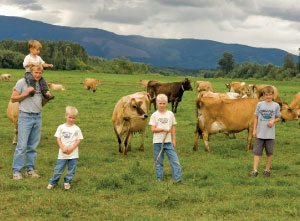The organic dairy business: the land of milk and money
by George Siemon
This article was originally published in September 2009

(September 2009) — You may have read that the dairy world is imploding, that the price non-organic farmers get for their milk has fallen 50 percent since last December — the fastest, deepest drop since the Great Depression.
As many as half the nation’s dairy producers — 20,000 — may call it quits by the end of 2009.
Some reports declare the good days even for organic dairy are over. It’s true that some conglomerates are not renewing organic dairy farmer contracts, leaving many — who invested so much — high and dry.
But we in the Cropp/Organic Valley Cooperative are holding onto our farmers for all we’re worth. We collectively agreed to reduce our supply across the board rather than drop anyone. Our cooperative model makes all the difference.
Even in the best of times, the economics of being a dairy farmer is frustrating. What we get paid for what we produce is not connected to the cost of production; prices paid go up and down beyond logic. Imagine not knowing what you’ll make until your check arrives!
This was why we created our organic dairy cooperative 21 years ago — the first “pool” of organic dairy in the United States. The vision was that organics must be sustainable for the land and the economics for family farmers. We insisted that the price be fair and stable and, for 20 years, we accomplished that goal.

The conversion to organic dairy has been a lifeline for many non-organic farmers. Organic dairy has offered a new economic paradigm with stable prices paid, based on the cost of production. Organic dairy is the biggest category in the organic sector.
It also is economically rewarding, enabling farmers to afford investments in the upkeep of facilities, and care better for their animals. Organic farmers are rewarded with recognition from the consumer for a job well done, which is radically different from the conventional model where farmers have no connection to the consumer.
Organic dairy farmers also are able to have hope to carry on their lifestyle and business, and see their children consider a future in farming. But probably the greatest reward for dairy farmers who convert to organic methods is the excitement they feel in rediscovering how to farm with nature.
Around 2004, there was a shortage of organic milk for an extended period when the market demand was growing rapidly. Big, new competitors entered the organic market, including many struggling, non-organic dairy companies. They procured large quantities of organic milk, hoping to grab market share and cash in.
It was the “Organic dairy (gold) rush,” an era marked by high prices, large signing bonuses, hauling costs and competition that ultimately was unsustainable. So many big farms converted to organic, there was too much for the market to absorb. Smaller farmers felt the pressure.
Things got worse with the recession — global export sales plummeted. The overall growth rate slowed from 25 percent to zero.
The new ethanol market, which keeps the cost of grain high, brought the retail price of non-organic milk to an all-time low — so low that organic milk today costs three times as much! The organic premium harmed organic dairy sales further. Organic dairy sales today are estimated to be five percent below last year.
Many organic dairy farmers are withdrawing or reducing their supply. Those left without purchase contracts won’t be able to afford organic feed without the organic premium. The worst part, however, is that if an organic dairy elects (is forced) to switch to non-organic feed and loses organic certification, the USDA rule prohibits it from returning to organic status!
Organic dairy producers are being challenged to react to this “perfect storm.” As a cooperative, we’re reacting with a community perspective.
We’re implementing a mandatory supply reduction of seven percent from the average of the last three years. We’ve never done this before, but we feel it’s critical that none of our members are forced out of the cooperative, so we’re all cutting back together. We’ll maintain a sustainable pay price and leave no one stranded.
The hardest hit farmers are those outside our cooperative who are being stranded without a market or being forced to take an unsustainable pay price. Today, cooperation is the most important value we hold dear as we face this challenge together.
George Siemon joined six neighboring family farmers in Wisconsin in 1988 to found the Cropp/Organic Valley Cooperative. Under his leadership, Organic Valley has become the largest, organic farmers’ cooperative in North America. Siemon also was instrumental in developing national standards for organic livestock certification.
Editor’s note: An Organic Valley dairy farmer is the featured speaker at PCC’s October [2009] member meeting.
